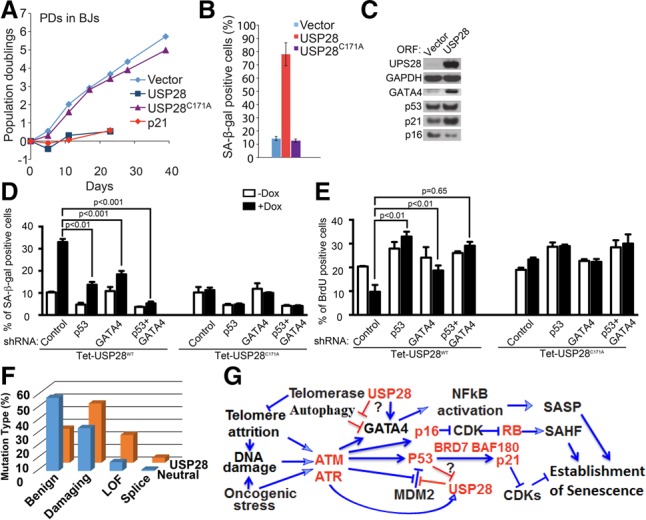Figure 3.

USP28 is a TSG that controls p53 and GATA4 in a catalytic activity-dependent manner. (A) Growth of mid-passage BJ fibroblasts expressing the indicated protein or empty vector. (B) Quantitation of SA-β-Gal staining in mid-passage BJ fibroblasts expressing the indicated protein or empty vector. (C) Western blotting of BJ cells expressing USP28 or an empty vector for 10 d. (D) SA-β-Gal staining on day 7 of doxycycline (Dox) treatment of BJ cells carrying a Dox-inducible vector (Tet-on) expressing either wild-type USP28 or the USP28C171A mutant and the indicated shRNAs. Data are mean ± SEM. Statistical significance was calculated by one-way ANOVA. Data are representative of three independent experiments. (E) Levels of BrdU-positive cells on day 7 of Dox treatment of the BJ cells described in F. Data are mean ± SEM. Statistical significance was calculated by ANOVA. Data are representative of three independent experiments. (F) The distribution of different classes of USP28 mutations in a collection of 8200 tumors compared with a typical neutral gene (Davoli et al. 2013). Polyphen2 was used to predict missense mutations as benign or damaging. A loss-of-function mutation is defined as either a stop codon or frameshift. (G) A schematic diagram indicating major senescence pathways driving cell cycle arrest and the formation of senescence-associated heterochromatic foci (SAHFs) and the SASP as well as points where USP28 acts within these pathways, with genes identified in this study indicated in red.
